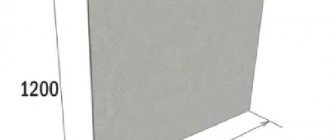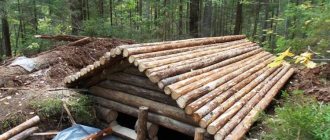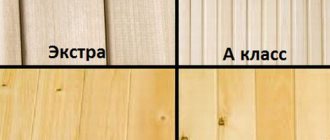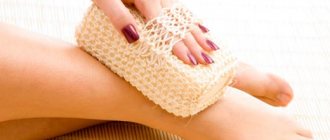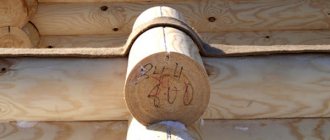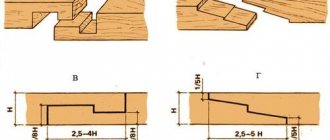Many of you have probably often seen a white coating on brick houses, but few know the name of this phenomenon.
In the construction industry, stains on brickwork are called efflorescence. This happens because the brick contains mineral salts. The material absorbs water very easily, thanks to its porous structure, which passes through the pores along with minerals and comes to the surface, leaving a white coating. It is very difficult to get rid of it in the future.
These processes occur under the influence of high levels of humidity, during periods of prolonged rain, then the bricks absorb water like a sponge, and with the restoration of dry days, the moisture gradually comes out along with the salt.
It is impossible to leave efflorescence on the mills; this will lead to the formation of cracks and destruction of the brickwork. As the cracks expand, they form a hollow space, which leads to collapse.
Why are efflorescences dangerous and why should they be removed?
White plaque or efflorescence on the brick not only worsens the appearance of the building. They have a destructive effect. If salt begins to appear on the brick, you need to urgently take action and solve the problem of how to get rid of the white coating on the brickwork. Otherwise there will be serious consequences:
- Accumulating in the pores of the brick, salts begin to destroy it from the inside;
- The surface of the brick crumbles under the influence of salts;
- Scaly chips appear on the brick;
- The stability of the masonry is compromised;
- Over time, cracks appear in the brickwork;
- The waterproofing of the walls suffers.
Efflorescence on a brick wall occurs for the following reasons:
- The brick is made from cheap raw materials with a high content of salts and other impurities;
- To prepare masonry mortar, water with a high content of hardness salts is used; when it begins to evaporate, a white coating appears on both the mortar and the brick;
- When making the masonry mortar, sand with a high salt content was used; if it is not washed, the resulting masonry will also have efflorescence;
- Violations in construction technology, namely, insufficient waterproofing at the foundation-wall interface. As a result, moisture can be sucked into the masonry.
- Carrying out masonry work in damp, rainy weather or excessive dilution of the solution with water for ease of use.
- The use of various frost-resistant additives and plasticizers.
- Wetting of brickwork due to the lack of gutters and roof eaves on the building.
Any of the listed factors, either individually or in combination with others, can cause efflorescence.
Salt stains on a brick wall not only spoil its appearance and disrupt the aesthetics of the building - this is only the first signal that not everything is in order with the facade and measures need to be taken. More importantly, efflorescence gradually destroys the brick, and the process begins from the inside.
Salt by itself will not dissolve or be washed away by rain. Repeating cycles of moisture absorption-evaporation-crystallization, combined with temperature changes, turns brick into a brittle material that begins to crumble and collapse.
Some time after the appearance of a white coating, scales and husks form on the surface of the brickwork, which eventually begin to fall off. The tension in the brick grows and it literally “tears” from the inside. This process is called salt corrosion.
General information about efflorescence
Why does efflorescence occur on brick?
The main rule for successfully combating efflorescence on bricks is to find out the cause of their occurrence, and only then take recommended measures.
Causes of efflorescence on brickwork:
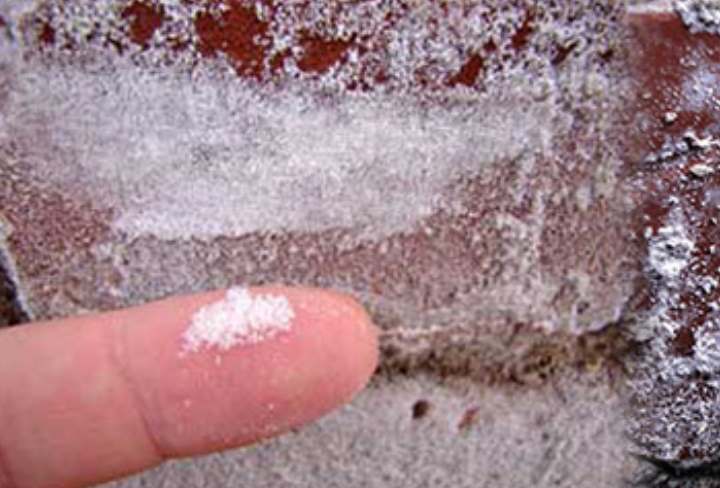
High salt content in the cement mortar and in the brick itself.- Penetration of salts from the soil through the foundation of the house along with water. This occurs due to poor quality waterproofing, groundwater is close to the surface or there is no drainage.
- A lot of rainwater with salts is pouring onto the walls. Such phenomena occur in areas with chemical industry or in coastal areas.
Note.
To prevent the formation of plaque on the brick in the form of efflorescence, construction rules should be followed. Otherwise, if there are formations on the masonry upon completion of the construction of the house, they must be removed without fail.
To ensure quality work, it is best to contact specialists who will analyze the chemical composition of the efflorescence and determine the components of the salts. Based on research, the optimal means for removing plaque will be selected. If you can’t afford this option, you can try to get rid of efflorescence on the brickwork yourself.
Rules
In any matter, you should adhere to an unspoken rule - it is easier to prevent a situation than to eliminate the consequences. So here, at the initial stage of building a house, adhere to the basic rules:
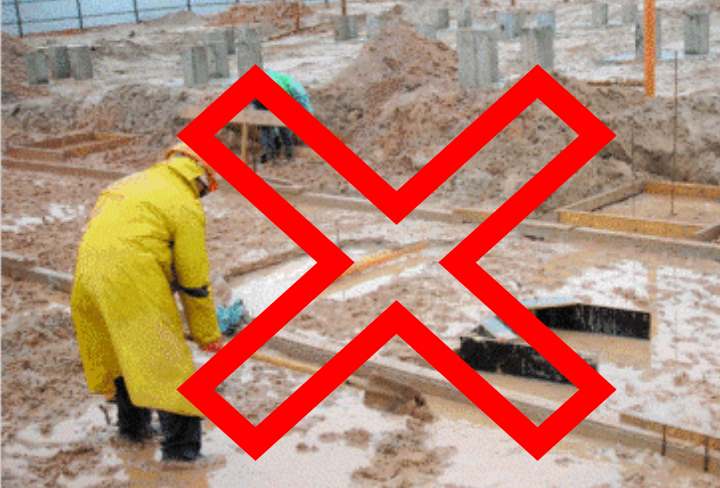
Hide the brick if it is directly exposed to precipitation, observing the storage conditions of the material.- Carry out thorough waterproofing of the foundation.
- Do not leave bare brick walls exposed during the winter.
- Do not carry out construction during rain, and cover already constructed walls from water with film.
- Substances that promote frost resistance and setting accelerators must be added in accordance with the standards, and in no case more.
- Do not soak the brick in water before starting laying, or use a very liquid solution. If cement gets on the outside of the masonry, it must be removed immediately.
- After the brickwork has dried, apply moisture protection products to the walls.
Note.
Before you begin work on removing efflorescence from bricks, study information about their nature, since salts can be easily and poorly soluble. Depending on this, the means of removal are selected.
Easily soluble efflorescences
These are sodium salts, potassium salts, sulfates and chlorides. The sparingly soluble ones include calcium, barium, aluminum, iron phosphate, carbonates (except sodium and potassium), and calcium silicate.
All salts that dissolve in water are removed by it, without much difficulty. But often, efflorescence is difficult to dissolve, so you will have to stock up on chemicals to remove it.
For those who are not going to seek help from specialists to remove efflorescence from brickwork, we advise you to go by exception. Construction stores offer a wide range of substances to combat efflorescence on bricks; they can be purchased in small quantities, after consulting with the seller. Apply products to small areas of the wall and determine the product that works for your problem.
Technology for cleaning brick from white plaque
The process of removing efflorescence and protecting the facade from its reappearance can be divided into 2 stages:
- removal of efflorescence;
- applying water-repellent impregnation.
Let's consider these points in more detail.
First, using a brush and a special remover, remove all the salt from the facing brick.
The compositions of cleaning agents vary. It's even possible to make them yourself. Or try washing off the salt with regular hot water.
But “folk remedies” are not so effective. When using such methods, you can remove efflorescence annually or even more often, but it will still return.
How to wash white deposits on facing bricks, you ask.
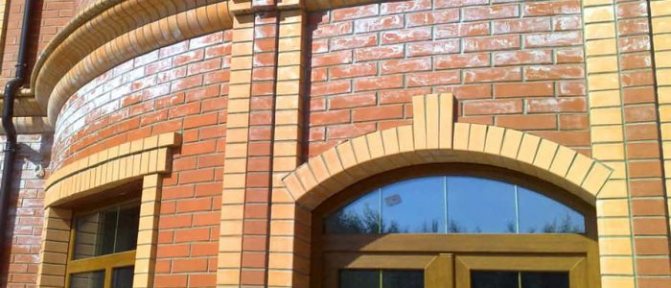
It is better to turn to proven, proven compositions that destroy the structure of salts from the inside. Fortunately, there are a great many of them in stores now.
Briefly about the main thing
To make the wall look like new always, and not just in the first months after construction, you must:
- Comply with all technological requirements for choosing a brick and store it under a film to protect it from rain or snow;
- Prepare a solution with a minimum of additives, river (or washed quarry) sand and water purified from salts;
- Observe the climatic and weather conditions of construction, installation and drying;
- Promptly clean the facade from emerging stains and protect the brickwork with a water-repellent agent from exposure to water.
You need to understand the causes and consequences of the appearance of efflorescence, that this is not some kind of problem that appears randomly, but a harsh reality that needs to be dealt with not later, but to organize the construction process in such a way as to avoid the very causes of salt deposits. It depends only on you what the appearance of the brickwork will be.
Ratings 0
Fighting efflorescence at the preparatory stage
The fight against efflorescence in preparation for the construction of walls will be more effective:
- Add special additives to the solution that replace lime and increase the plasticity of the solution. In ancient times, chicken eggs served as such an additive. Today, the chemical industry offers water repellents made from petroleum, rosin, vegetable oils, and organic additives. Applying a plastic mortar allows you to block moisture in the pores of the brick by compacting the masonry. Even if salts are present, they will not be able to escape to the surface of the wall. Efflorescence may appear, but in small quantities.
- It is necessary to adhere to the deadlines for drying the walls. Plaster cannot be applied to damp walls, otherwise in the spring, in the sun, the outer sides of the walls will be completely covered with white coatings.
- Do not over-moisten the masonry - soak the bricks, make a liquid mortar. It is not recommended to start construction work in the autumn-winter period, so as not to decide in the spring the question of how to get rid of white plaque on brickwork.
We invite you to familiarize yourself with Chimneys for sauna stoves: creating a project and building it yourself
There are several methods for removing white plaque from brickwork.
A visible feature of efflorescence is the unsightliness of the front surface of the cladding. However, a more significant problem with efflorescence is the destruction of the brick structure. The front surface of the material first becomes scaly, and then large cracks form, which lead to the destruction of the block.
In this way, the entire facing masonry deteriorates not only in terms of external characteristics, but also its integrity is destroyed, which leads to a decrease in its heat-saving indicators, protective properties and other qualities.
It is especially important to take care of the brick if insulation is laid between the facing masonry and the load-bearing wall: if the lining is destroyed, the insulation may become unusable, especially if the cause of efflorescence is poor-quality waterproofing.
- Cleaning with ordinary water. For this method, you can use a high-pressure cleaner or a regular garden hose. In the latter case, processing will take much longer. Efflorescence is simply washed off with clean tap water. By carrying out such cleaning, you will, of course, wash away the efflorescence that has appeared, but after a short period of time they will appear again. The thing is that by exposing the brickwork to water, you gradually saturate it with liquid, which will subsequently wash away even more salts.
- Cleaning using special chemicals. This method is based on the use of modern chemistry. A special composition is applied to the surface of the wall, left for a certain time, and then washed off with water; it is better to do this with a brush in order to remove efflorescence as efficiently as possible. After the white coating on the brickwork has been removed, it is advisable to apply a water repellent to it to prevent the reappearance of salts.
Special products for removing efflorescence
Cleaners vary in composition and purpose. You should choose a suitable product depending on the type of surface being treated and the type of efflorescence. Whatever option you choose, after applying the composition (in “store-bought” compositions the time is indicated on the packaging or in the instructions for use), wash it off with plenty of water. Then, to To consolidate the result of removing salts from brickwork, it is necessary to treat dry and cleaned walls with hydrophobic impregnation.
This impregnation is an invisible thin film that protects the facade from the negative effects of moisture, while maintaining the “breathing” properties of the brick. Such impregnations, especially deep penetration ones, can protect brickwork for years.
Let's sum it up
- You shouldn’t hope that all the efflorescence will simply be washed away with water (rain), since water is just a temporary removal measure, and the plaque will soon appear again.
- Even acids such as hydrochloric or acetic acid are unlikely to remove plaque for a long time. There are regular cases when, after treatment, salt appears again after a short time.
- If you decide to use a purchased composition, then it is better to choose trusted manufacturers. 4. Be sure to secure the result with hydrophobic impregnation.
Now you know how dangerous efflorescence is, how to wash off the white deposits on facing bricks, and how to do it. This method is also suitable for other surfaces. For example, for walls lined with stone. We wish you to forget about white stains on your facade forever!
Salt stains on brickwork can and should be removed, but this should not be done using ordinary water, as it increases the moisture content of the brick, and when it dries, the salt will appear on the surface again.
The use of special chemicals in this case is justified; moreover, it is reliable and safe if you follow the rules of use.
There are always instructions on the jar with the cleaner, which indicate in what proportions to dilute the product with water, how to apply it, and how long to wait before rinsing. For application, sprayers, rollers, and natural brushes are used. After distributing the product, you need to wait from 10 minutes to half an hour, and then rinse it off with plain water. You cannot use metal objects for this; a wooden scraper or a stiff brush is sufficient.
The complete process of cleaning and protecting brickwork from efflorescence consists of the following steps:
- Removing efflorescence using a special solution and a brush.
- Rinsing the brickwork with plenty of water, you can use a household mini-wash for convenience or other devices.
- Treatment with a special composition that reduces the porosity of the brick, which prevents further release of salts to the outside.
- Application of a water-repellent substance, which creates a protective film on the surface that does not allow moisture to pass through. It is recommended to apply this product in 2 layers. After applying the first, you need to wait 24 hours, then apply the second layer to the completely dry brick. The water repellent can penetrate up to 1 cm inside the brick, providing protection from moisture for 5-10 years. Then it needs to be reapplied.
After each stage, the brickwork must be completely dry, only after this can you proceed to the next one.
To remove efflorescence on large surfaces of tall buildings, they resort to the help of special organizations that professionally carry out cleaning. In such cases, a sample of salt deposits is taken and the most effective means for removing efflorescence is selected based on chemical analysis.
We suggest you familiarize yourself with How much cement is needed for laying a cinder block
How to prevent efflorescence
To keep the brickwork intact, it is better to take care of the problem of efflorescence in advance. After all, preventing their occurrence is easier and cheaper than repairing the wall in the future.
Recommendations for the prevention of efflorescence directly follow from the possible causes of its occurrence.
Brick quality . Before purchasing a batch of bricks for construction, you should ask the manufacturer about the composition of the raw materials, manufacturing technologies and the quality of the products.
Hardness of water. The water used at a construction site to prepare the solution should be checked for hardness. If you find that the water is “hard,” you need to filter it first, if possible.
Washed sand. If the masonry mortar is mixed directly on site using sand, then you need to track where you plan to import this sand from and what its salt content is. But it is better to use ready-made dry construction mixtures from trusted suppliers.
Foundation waterproofing. Reliable insulation at the junction of the foundation and the brickwork will prevent moisture from the soil from penetrating into the walls and causing the process of efflorescence.
Work in dry weather. The recommendation may seem banal, but building brick walls in dry weather helps protect the internal structure of the masonry from excessive moisture.
Additives to the solution. If construction conditions allow, then it is better to limit or completely abandon the use of antifreeze additives and various hardening accelerators.
How to remove salt from brick using folk remedies
There are traditional ways to combat efflorescence on a brick wall. They will help remove white plaque just as well as industrial chemicals. The most well-known means are:
- You can wash off the plaque with a solution of ammonia prepared in the following proportion: 1 bottle of ammonia per 2 liters of water. The solution is applied to the wall and then washed with hard brushes.
- Efflorescence can be washed off well with a vinegar solution. You need to dilute 2-3 tablespoons of vinegar in a bucket of water, adding a little detergent, then apply the solution to the masonry and rinse with water after 10 minutes.
- They also use a solution of hydrochloric acid (2-4%), which can be bought at a hardware store. It is applied to a damp wall and then washed off with a stream of water.
Each of these methods is based on the use of acid solutions that react with salt deposits and neutralize them. To find out which solution will be most effective in a particular case, use the selection method. Apply the solution to a small area, leave for 10 minutes, rinse with water and evaluate the result.
Some adhere to a simple method of removing plaque without auxiliary means by mechanical scraping.
After removing plaque by any means, you need to take measures to prevent its reappearance. And to do this, it is necessary to find out the reason for the formation of efflorescence. If possible, it is necessary to eliminate it, and also treat the wall with a water-repellent compound.
How to remove efflorescence on brick?
All measures to combat efflorescence can be divided into two large groups. The first group includes a set of actions to prevent and prevent the occurrence of efflorescence. They concern the rules and regulations in the field of brickwork and its features. However, it happens that the building has already been built, and the white coating on it is taken for granted. In this case, efflorescence will be removed and an attempt will be made to stop its occurrence. First, let's look at the first group.
If you follow the rules for the construction of brick structures, as well as its acquisition and storage, it is highly likely that you will be able to avoid further troubles with the crystallization of salt solutions.
Buy bricks only from a trusted supplier. By this you compensate for possible violations during the production of this building material. In a bona fide enterprise, a violation of technology is more an accident than a deliberate act. Feel free to purchase a small test batch and test it in the field. After all, eliminating troubles in an already built house will be much more expensive.
Store bricks in dry conditions, in the shade. The ideal option is under a canopy. If pallets are scorched during production, do not unpack them ahead of time. If a brick constantly gets wet and then dries in natural conditions, this leads to its saturation with salts.
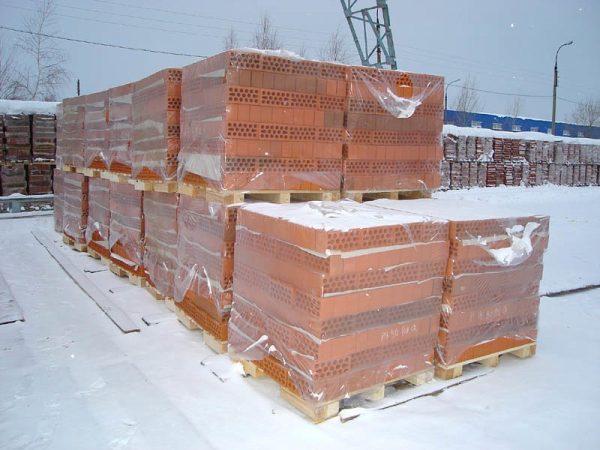
It is better not to unpack factory pallets before starting work.
Create a calendar of construction work. Based on the climatic characteristics of your region. Usually the end of spring, the second half of summer and the beginning of autumn are the most favorable times for construction; usually at this time it is quite warm and dry. Monitor the weather forecast and its current condition. Do not lay masonry in the rain and do not require this from your workers. Sometimes it is better to wait a little so that the work is of better quality.
Pay special attention to preparing the mortar:
- It is better to take river sand; if funds do not allow this, you can take quarry sand, but it must be washed, although this will increase the cost of construction.
- The softer the water you use, the better. If there is a clean reservoir nearby that is not connected to the central water supply system, it is advisable to take water from there for testing - perhaps it is softer than what flows from your tap. If funds allow, install a softener filter and do not skimp on the construction of this water.
- Do not make the solution too thin. Carefully measure the amount of sand and cement so that later you do not have to add water to the already prepared mixture. The masonry mortar must be fresh and strong so that it does not drip from the trowel or trowel.
- Use less various modifying additives. But the use of liquid soap is acceptable, but in small quantities. The fact is that liquid soap or detergent promotes the plasticity of the solution, replacing an amount of liquid that is two to three times greater than the volume of the product. By doing this, you also minimize the amount of water introduced, improving the performance characteristics of the solution.
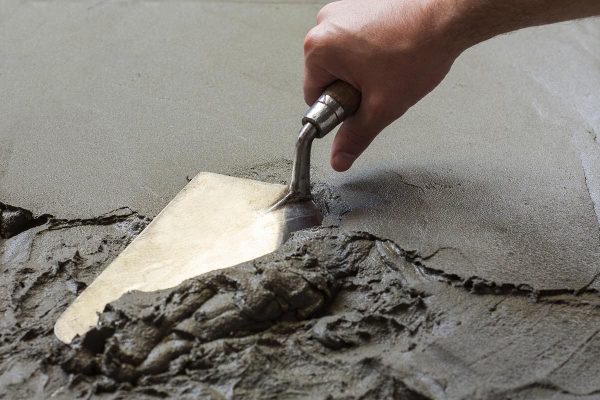
The solution should not expel water
After the brick wall construction phase has been completed and a break is planned, the structures need to be properly “mothballed,” especially for the winter. Sections of walls built up to the current level are covered with plastic film. If you plan to complete the construction of a house in one season, include the construction of a roof in the calculation so that the box can winter under the roof. This will reduce the risk of efflorescence and brick failure in the future.
If you have spent a lot of money to cover your house with facade decorative bricks, then salting out will violate the main idea of this action - the aesthetics of the appearance and protection from adverse environmental conditions, because over time the brick may begin to peel, crumble and fall apart.
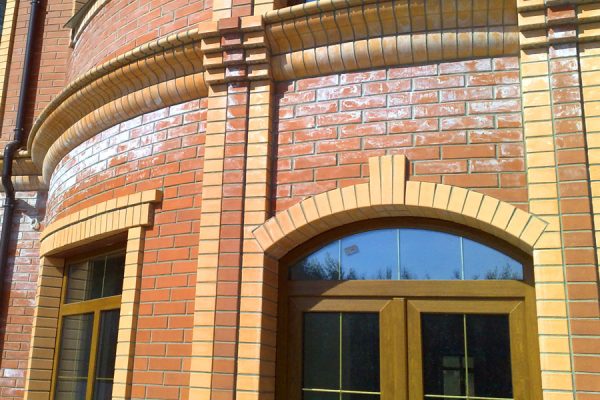
The appearance is hopelessly damaged
Today, the construction chemicals industry offers the concerned owner a whole arsenal of ready-made products for removing efflorescence. These substances are usually packaged in plastic canisters with a volume of 1 to 5 liters. All of them are supplied in concentrated form and must be pre-diluted with water.
Look on the shelves of construction supermarkets for canisters labeled “anti-salt”, “efflorescence remover” and the like. Pay attention to the composition. It is similar for all such drugs - it is mainly diluted acid and surfactants. The higher the percentage of active ingredients, the stronger the effect you can get from use.
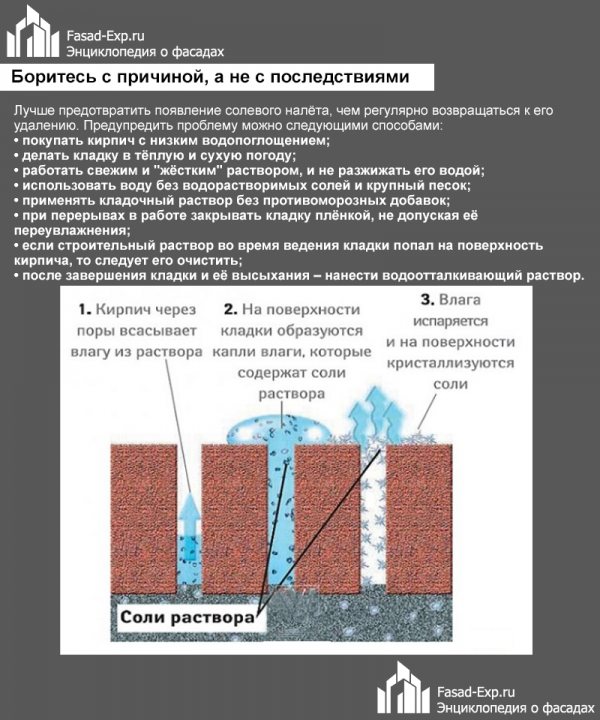
It’s better not to let the brick break
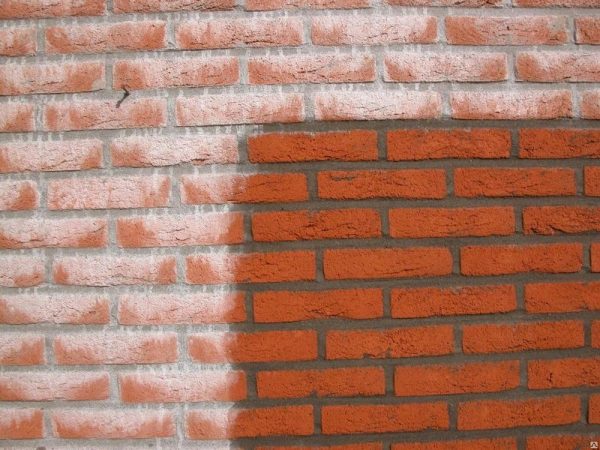
Effect of "anti-salt"
Protective suit
After treatment, you need to wait a few hours until the white marks disappear, and then wash the facade with a garden hose or the same sink. This is done so that the active ingredients do not remain in the brick and the medicine does not become poison.
If the section of the wall is small, you can try to remove it manually using a mechanical method - take a stiff brush, perhaps with metal bristles, and pour water on it, rubbing until the efflorescence is removed. The work is not easy and also destroys the brick, so it can be recommended at the homeowner’s own risk.
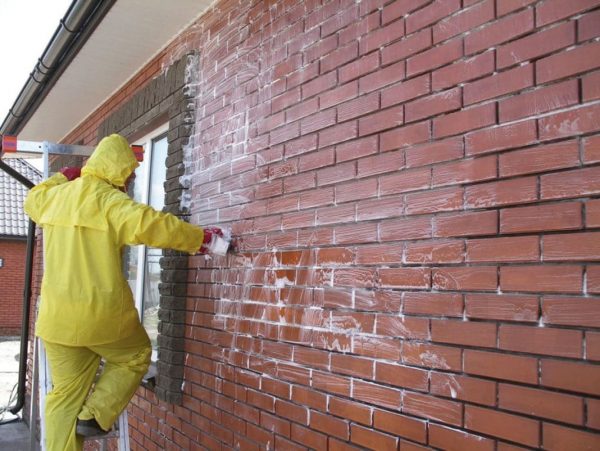
Application of anti-efflorescence composition
Table 1. Step-by-step instructions for a folk remedy for removing efflorescence.
We invite you to read: What is a soft blind area for a well, how to make it?
| Description | Photo |
| Step 1. Carry out a thorough visual inspection of the walls. If you see that the efflorescence has collected in a crystalline coating, take the time to go over these places with a brush with hard and short synthetic bristles. | Cleaning the surface |
| Step 2. Prepare a solution for treating bricks. To do this, dissolve 1–2 bottles of ammonia from the nearest pharmacy in a bucket of clean water. | Preparing the solution |
| Step 3. Test the product on a small section of the wall. If the effect is weak, you need to make the solution stronger. To do this you need to take hydrochloric acid. A 10-liter bucket will require about 150 ml of pure HCl. If you don't have hydrochloric acid, you can take sulfuric acid, just be careful with it. There is no need for pure acid; just pour a little electrolyte for car batteries, which every motorist has, into a bucket. | Check the solution, add concentrations if necessary |
| Step 4. Apply the composition with a wide brush or brush, as if you were rubbing it into the pores of the brickwork. Salts will drain along with the solution. | Rub in the solution |
| Step 5. After treatment, after a while, water the wall with a garden hose to remove any remaining substances. | Wash away the remains |
Water repellent - creates a film with water-repellent properties on the surface of the brickwork. Water does not wet the brick surface, and efflorescence does not appear. True, it needs to be updated at certain intervals.
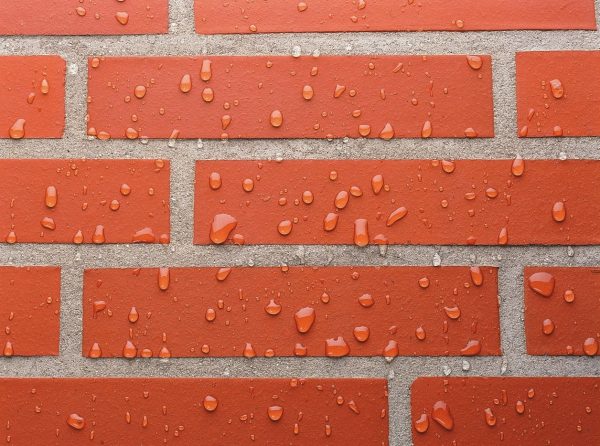
Wall after treatment with water repellents
Acrylic impregnation - this substance creates a waterproof film on the facing brick. This product is expensive, but it actually waterproofs the masonry for a long time.
It will not be possible to wash off salt deposits from brickwork with plain water, especially since it will be absorbed into the brick and cause a fresh deposit of salt to appear on its surface. Removing efflorescence is a complex measure that includes cleaning the surface of the walls with a special product. Since the composition of efflorescence is varied, first of all it is worth trying the action of a universal remover in an inconspicuous place. If it does not help, you will have to select special means until an effective one is found for a particular case.
Removal methods
If stains begin to appear, you need to immediately take measures to eliminate them; you should not put it off for later. There is a misconception that the salt layer should simply be washed off with water. Treating the surface with water will cause the salts to dissolve and move inwards. Such a wash will only worsen the damage to the masonry. Cleaning bricks from efflorescence can be carried out mechanically or using chemical cleaning mixtures.
Mechanical cleaning
Removing stains using mechanical methods requires considerable physical strength. The surface must be thoroughly rubbed with hard brushes until the entire white layer can be removed. With a small area of damaged surface, this can be done.
Great luck - having a sandblasting machine. The work must be carried out competently in compliance with safety rules. Using a compressor, a stream of air with sand is pumped onto the contaminated surface, under the influence of which not only white stains of salt are removed, but also the remains of the concrete mixture, stains of soot, paint, mold, and moss. Work must be carried out wearing a mask and goggles to prevent particles suspended in the air from reaching the mucous membranes.
Detergents
Judging by the reviews, good results are provided by special cleaners presented in a varied assortment. In most cases, universal formulations help to successfully cope with the problem.
First, the product must be diluted in water according to the instructions, then apply the solution to a small area of the masonry. After a few minutes, in accordance with the recommendations, the composition can be washed off with water. Then the wall should be thoroughly dried and covered with a hydrophobic layer, which will penetrate several centimeters deep and provide reliable protection for a long time.
If you cannot buy special compounds, you can get by with homemade solutions of hydrochloric acid with a concentration of 2% to 4%. If the layer of salt stains is thick, the mass fraction of acid in the solution should be increased to 6%. Work on cleaning brickwork with hydrochloric acid solutions must be carried out wearing a mask, since acid fumes are harmful to the body.
We invite you to familiarize yourself with a dousing bucket for a bath: a large bucket for dousing with your own hands
To remove efflorescence, some experts recommend treatment with a solution of copper sulfate, obtained by adding 1 part of the substance to 9 parts of water. For a number of reasons, the method is questionable. Copper salts can disinfect the surface, but how they should dissolve the deposits of other salts is not entirely clear. In addition, copper sulfate can color the brick bluish or give it a strange tint.
Other craftsmen testify that a solution of ammonia helps get rid of stains. The recommendation is also very dubious. Perhaps in certain geographic areas with a predominance of acidic salts, weakly alkaline ammonia solutions worked. Everyone should not follow this advice.
Efflorescence on walls is a long-known problem. The population with normally increased aesthetic requirements, who do not want to see dilapidated buildings, can use a variety of opportunities to prevent and eliminate defects.
The first thing that comes to mind is to wash the wall to remove white stains. This method is acceptable, but ineffective. A washed wall will look like new. But after drying in the sun, the brickwork will turn white again. The whole point is that soluble salts are washed off, and there are salts that are not afraid of water. Moreover, excess moisture only activates the growth of new salts in the pores of the brick.
The chemical method of removing white plaque on brickwork is of better quality and takes place in several stages:
- The brick is cleaned with a special product. The cleaner is selected depending on the types of salts on the masonry. Read the instructions and test on a small area of the wall.
- The remover is diluted with water according to the instructions and applied to the wall using a brush or sprayer. The washing liquid contains surfactants and acid, so safety rules must be followed.
- The remaining solution must be washed off with water from a hose under pressure.
- When the wall dries out, the masonry is hydrophobized. The result is a waterproof film that penetrates several centimeters into the brickwork.
The walls of a house treated with water repellents always look clean, do not allow moisture to pass through, become more durable, but remain vapor permeable.
You can buy special products and water repellents that will definitely solve the problem of how to get rid of white plaque on brickwork forever in specialized stores. Check out the product and its quality on our website at any time.
Causes
- The technology for making bricks has been violated (excess of water or anti-frost additives);
- Use of cement-sand mixture with a high lime content;
- The composition of mortars for bricklaying - it may also contain salts that will come out over time;
- Low-quality bricks, in the production of which they save money by firing at a lower temperature - the quality deteriorates significantly.
To prevent the appearance of efflorescence during construction, it is worth using so-called plasticizers. By adding this chemical composition to the solution, we achieve the replacement of lime with components, which makes it possible to bind the masonry.
To remove white deposits on brickwork, using the method of washing with water using a brush is not suitable, since we will only make the situation worse. As you know, fresh water tends to attract salt. By spraying the walls with a hose, we speed up the process of destruction of bricks and walls, especially in the autumn-winter period, when the temperature changes sharply. It is warm during the day and very cold at night.
It is much more effective to use chemical solutions; modern industry offers a huge variety of them. For these purposes, it is necessary to find a special composition against efflorescence. Read the instructions for use carefully and begin cleaning.
First you need to clean the surface of the wall from dirt. Slowly apply the chemical solution to the affected area and wait until the reaction is complete. After treatment, it is necessary to remove the remaining composition with clean water. Next, you need to wait until the wall dries and apply a protective layer. Experts recommend hydrophobization (waterproof impregnation of bricks). After this treatment, your walls are no longer in danger!
If you are in doubt about which option or product to choose to remove white plaque on brickwork, write to us, we will definitely help you.
The main reason for the formation of efflorescence on brickwork is the crystallization of soluble substances that are part of the raw materials for bricks and the mortar. In this case, the brick can be anything: ceramic, clinker or silicate.
The process of formation of excess salts occurs as a result of increased water absorption of the facing material. As a result of high humidity inside the brick in cold weather, water freezes in the structure of the material, which leads to its destruction.
Efflorescence indicates that the surface of the brickwork requires measures to protect the surface from excessive exposure to water. To do this, it is necessary not only to cover the surface with protective agents, but also to check the canopies, roof, and window sills for leaks, as a result of which water gets onto the wall.
Causes of efflorescence beyond human control may include the following factors:
- the sand that is used to prepare the solution may be oversaturated with salts due to the lack of measures to wash it during the extraction process;
- the presence of salts in the composition of raw materials for the production of ceramic blocks contributes to high moisture absorption due to the porous structure of the material;
- the presence of a large amount of salts in the water used for the production of bricks or concrete mixtures;
- groundwater;
- location of the premises next to a chemically hazardous enterprise, due to which natural precipitation carries aggressive substances.
There are other reasons why salt stains may occur on the surface of brickwork:
- improper preparation of the solution in violation of the proportions, in which excess water predominates;
- poor quality material;
- use of cement-lime (or lime) mixtures;
- poor quality waterproofing;
- lack of protection from snow and rain.
CAREFULLY!
Low air temperature, at which crystallization of salts occurs, and a predominantly humid climate are a comfortable environment for the formation of efflorescence.
Therefore, in areas where rain prevails, and in the autumn-winter period the temperature drops below -5°C, the appearance of efflorescence is almost inevitable.
Efflorescence on interior walls. Causes of efflorescence
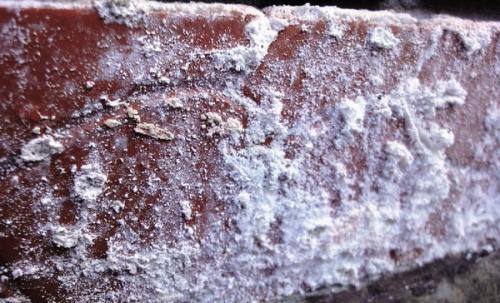
Efflorescence, or salt stains on the surface of paving slabs or bricks, not only spoil them, but contribute to their destruction. Therefore, the fight against them must be carried out as soon as they are noticed, otherwise delay may contribute to the destruction of the facade and tiles.
Chemical causes of efflorescence
These reasons include, first of all, the increased salt content in the water or building material from which the solution was made:
- High water hardness, that is, the content of calcium salts in it. They bind to cement and therefore become poorly soluble compounds. When water gets inside a tile or brick, the salts are pushed out;
- The presence of salts in cement and other solutions;
- Proximity of the area where facade or paving slabs are laid to chemical production;
- Presence of binders in solutions. The most common binding agents used in the preparation of mortar include calcium hydroxide (slaked lime). In some cases, it contributes to the appearance of carbonate efflorescence, which is difficult to remove;
- The presence of sulfur dioxide in the atmospheric air. When reacted with water, it forms sulfuric acid. If there are calcium compounds in the solution, gypsum is formed;
- The presence of a huge amount of other pollutants in the air.
Humidity is the culprit in the formation of efflorescence
High humidity is one of the most important factors in the formation of efflorescence on the surface of tiles or bricks. Tiles or bricks absorb large amounts of soluble salts, which then rise to the surface under the influence of capillary forces.
Groundwater is also to blame for the appearance of efflorescence. They penetrate into the thickness of the tile or brick and, as they evaporate, leave white marks. Since groundwater is mostly rich in mineral salts of various origins, as they push out and slowly dry out, a dense crust forms.
The reasons for the appearance of efflorescence also include the storage conditions of tiles or bricks. If it is covered with plastic film, then over time, effusions form on the surface of the materials, which help push salts to the surface. Sometimes in such cases, efflorescence can even appear on the surface of tiles or bricks that have not yet been laid on the surface.
Other causes of efflorescence
Often, during the preparation of a mortar, substances are added to it that prevent freezing or promote rapid hardening. Despite the fact that they make the work easier, if you add them in large quantities, salts are formed.
Efflorescence also occurs when construction techniques are not followed. For example, when work is carried out at low temperatures or in conditions of high humidity. In all these cases, brick or tiles become very vulnerable to the appearance of efflorescence and their destructive effects.
Since removing efflorescence is quite difficult, it is necessary to pay careful attention to the construction technique.
